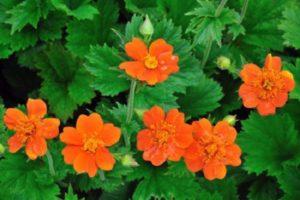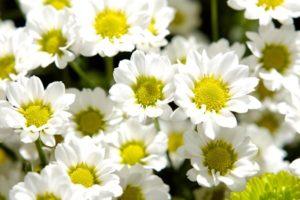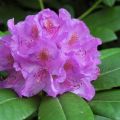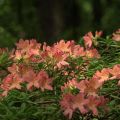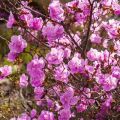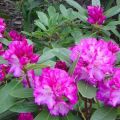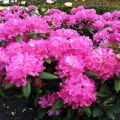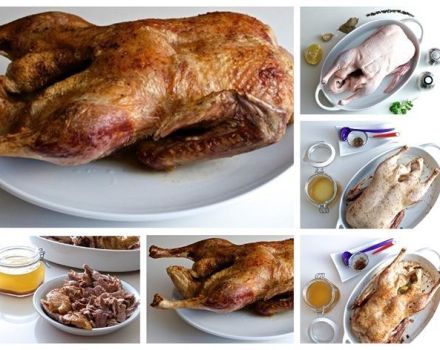Description and characteristics of 16 subclasses of Yakushimansky rhododendron, planting and care
Rhododendron (azalea) Yakushimansky - a beautiful shrub, brought to the territory of Europe from Japan a hundred years ago, won the hearts of gardeners in our country. The evergreen plant reaches a maximum height of 1.5 meters. The shrub has taken root well in Russia, as it can withstand frosts down to -29 C. Breeders are actively experimenting with the Yakushimansky rhododendron, actively crossing it with other species.
Brief definition
Yakushiman rhododendron is a tree-like shrub with large original flowers with a diameter of 7 centimeters.
Detailed description
Yakushiman azalea is a natural form of the Degron rhododendron.
View characteristic:
- Leaves are dark green, narrow, glossy.
- Flowers are large, collected in inflorescences.
- Slow-growing bush up to 1.5 meters high.
- The stems of the plant are treelike.
- The root system is superficial.
- Flowering lasts from May to June.
Rhododendrons are classified as poisonous plants. Toxic resin forms on the leaves. If the sticky substance remains on the hands or gets into the oral cavity, then poisoning cannot be avoided. All work with rhododendrons must be carried out with gloves. Animals and children are in an area of increased danger; it is better not to let them near the bushes of the Japanese azalea.
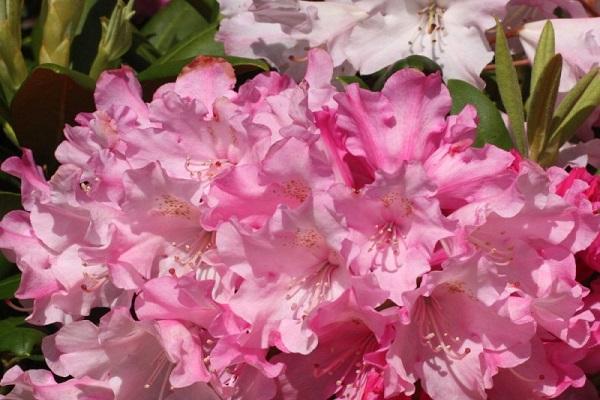
History of origin
The small Japanese island of Yakushima is the birthplace of the Yakushiman rhododendron, where it grows in the mountains and on the hills. The path to Europe began at the beginning of the 20th century, in 1934 the shrub was brought to Great Britain, then rapidly spread throughout the continent, and gained popularity in Russia.
Distinctive features
The Yakushiman rhododendron can beautify any landscape. It differs from its counterparts in a number of features:
- Extended flowering period.
- Undemanding to soil, can grow among stones.
- Frost and winter hardiness.
- Does not tolerate direct sunlight, partial shade and regular abundant watering are necessary.
Leaves do not fall for the winter, the shrub belongs to the evergreen species.
Important! When planting, the root collar cannot be covered with soil, the process of decay of the root system may begin.
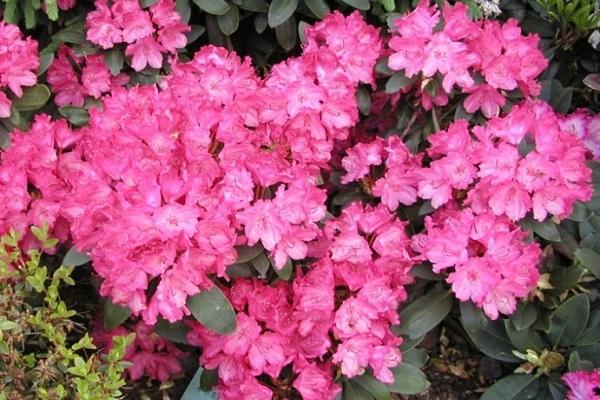
Subsort
The varietal diversity is represented by various hybrids of the Yakushimansky rhododendron. In order not to be disappointed in the plant, they buy seeds and seedlings from trusted retail outlets, certified producers.
Kalinka
Sprawling spherical bush up to 1 meter high. Forms flowers of rich classic pink color with a border at the edges of the petals. Frost-resistant variety, prefers partial shade and fertile chernozem soils.
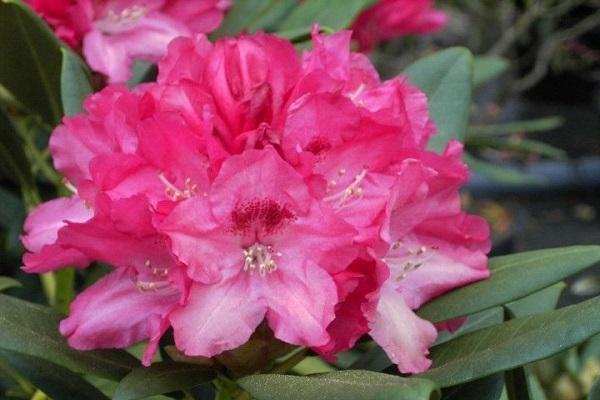
Percy Weissman
Hybrid rhododendron with luxurious salmon pink flowers. Differs in increased frost resistance, able to withstand frosts down to -30 C. In inflorescences forms up to 12 flowers with a diameter of 6 centimeters.
Marrakesh
Sprawling bush up to 70 centimeters high. Leaves are elliptical, glossy, dark green in color. Flowers of white-pink color are collected in gorgeous inflorescences. Forms a columnar shape.
Fantastic
Ideal for temperate climates, characterized by increased winter hardiness, withstands frosts down to -30 C. Forms flowers of deep pink color along the edges, with a delicate pink center inside, collected in inflorescences of 12 pieces.

Schneekrone
Forms a compact bush of regular shape. The buds of pale pink color, blooming, turn into a snow-white flower with charming pink freckles inside. The height of the bush is up to 1 meter. Average winter hardiness.
Golden Torch
Forms 15 inflorescences on one bush. The flowers are warm, pale white. The bush is less than 1 meter high, the winter hardiness is weak, it needs additional shelters for the winter season.
Bluretta
It has a slow growth rate compared to other rhododendrons. Weak winter hardiness. Forms flowers in the form of bells, collected in inflorescences. The edges of the petals are corrugated, the color is deep pink.

Mist Maiden
A spherical, slow-growing bush designed to decorate the territories of summer cottages and household plots. The flowers are large, pale pink in color, gradually acquiring a white color. Possesses high winter hardiness.
Caroline Albrook
Variety of English selection. Blooms profusely from May to late June. Forms large flowers of original lilac color with golden-brownish patterns inside. A spherical bush, up to 120 centimeters high. Good frost resistance, tolerates air temperature in winter to -25 FROM.
Emanuela
An evergreen shrub that grows strongly in width and can reach a height of 2 meters. Average winter hardiness, needs additional shelters for the winter. Forms contrasting flowers of a delicate pink shade with bright pink fringes along the edges of the petals.
Lumina
A spherical bush less than 1 meter high, with large lilac-pink flowers. Average frost resistance, flowering duration - 3 weeks. Leaves are dark green, elongated, matte.

Dock
The hybrid variety of the Yakushimansky rhododendron forms a medium-sized spherical shrub. The flowers resemble lilies of the original lilac color. Prefers partial shade, does not tolerate stagnant moisture and clay soils.
Mix
Mediterranean species, poorly tolerates temperature changes, prolonged cold snaps, frosts. Flowers are not large, bright pink color. Suitable for indoor growing.
Silver lady
An evergreen shrub with slightly curved leaves. Forms delicate white flowers with a pink tint. Average winter hardiness. The bush begins to bloom profusely at a young age. The height of an adult shrub is less than 1 meter.
Isadora
A rare variety with large pink flowers that resemble lilies. The leaves are dark green on top of the leaf plate, brown on the back.Prefers partial shade, does not tolerate stagnant moisture.
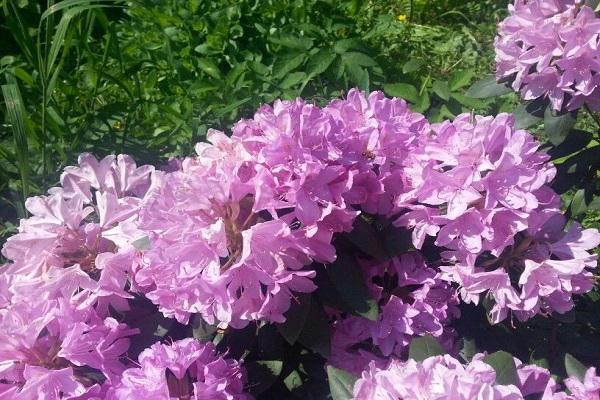
Hummingbird
Spherical compact bush 80 centimeters high. Inflorescences are delicate pink. Looks great in alpine slides and single landings. Average frost resistance, requires shelter for the winter.
Growing
The success of its cultivation depends on the correctly selected variety of rhododendron. For temperate latitudes, zoned varieties with good winter hardiness are suitable.
Site and soil selection
All species of azaleas do not tolerate waterlogged soils, but prefer to grow in partial shade.Important! Direct sunlight hitting the shrub for a long time can ruin the plant.
The site must be protected from drafts and located on a plain. The soil for rhododendron should be slightly acidic and rich in nutrients. At the bottom of the dug hole, expanded clay and sand are piled.

Planting
The optimal time for planting Yakushiman rhododendron seedlings is the end of April. Soil temperature should be more than +10 C. Azaleas are often planted in separate bushes, group plantings look spectacular, you can create hedges.
Temperature
Yakushiman rhododendron is a heat-loving plant, most varieties require shelter for the winter. You should not rush to plant bushes in open ground in early spring. The threat of frost must pass, the soil must warm up.
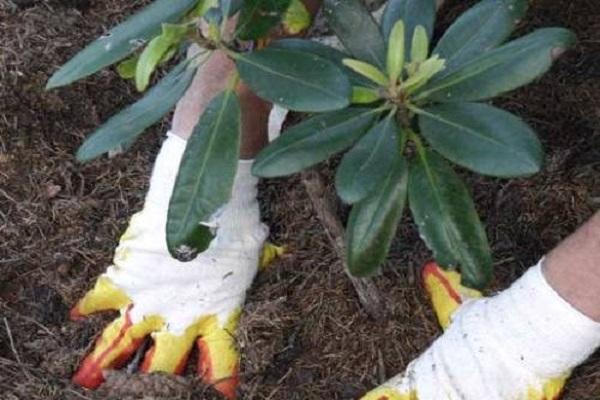
Watering
It is necessary to spray and water the plants regularly and abundantly, about 2-3 times a week. Overdrying of the soil and the formation of a solid clod of earth in the root system should not be allowed. The optimal time for watering is in the morning and evening hours.
Top dressing
Rhododendrons do not need abundant feeding with organic fertilizers; you can use special mineral complexes for azaleas. Top dressing is introduced in three stages:
- before flowering;
- after flowering;
- at the beginning of autumn.
It is important to choose the correct dosage, experienced gardeners often dilute mineral complexes with water in a 2: 1 ratio. The bushes that woke up in early spring are sprinkled with wood ash.

Pruning
Shrubs are pruned on rare occasions, mainly to correct the shape of the plant and remove dead stems and branches. After the end of flowering, the flowering stems are removed so that they do not spoil the appearance of the bush and do not take away the strength from the plant.
Transfer
Rhododendrons easily survive a transplant if it is done in early spring or fall. It is important not to damage the delicate root system of the plant. The bush is dug up together with an earthen lump and transplanted to a new place. It is best to transplant in the evening or cloudy weather.
Wintering
There are varieties with increased winter hardiness that can survive frosts at -30 C. But, according to the experience of gardeners, it is recommended to cover shrubs for the winter. Spruce branches and special covering materials are used as plant protection. The foliage on the rhododendron is left, it serves as an additional shelter.
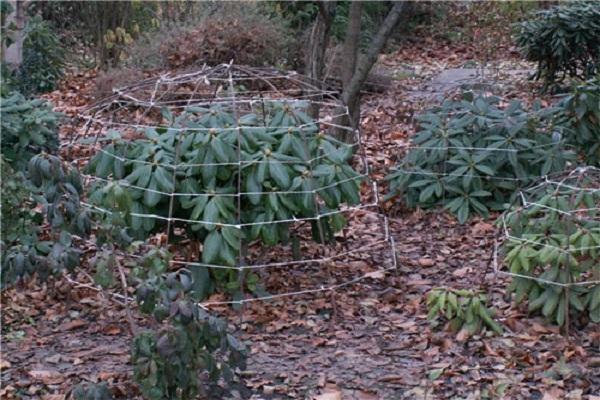
How to propagate
It is not difficult to propagate rhododendron in your area, each grower chooses the most comfortable way for himself.
Division
Combine with the transplant process. The bush is dug out of the ground, being careful not to damage the root system. One bush can be divided into 2-3 new young plants. After 2-3 years, the rhododendron will delight gardeners with its first beautiful flowers.
Seed
Planting material in the form of seeds can be purchased at a specialized store. Planting is carried out in seedling boxes in mid-February, keeping the distance between the shoots according to the recommendations for each variety. The box is covered with a film, after 7-10 days the first shoots appear.
In April-May, young bushes are planted in a garden bed "for children" or they immediately choose a place on an alpine slide, next year the bushes can be planted in permanent places.
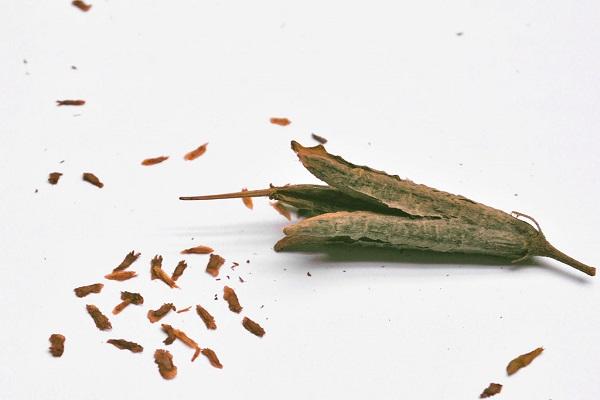
Cuttings
Rhododendron has tree-like stems.To propagate the plant by cuttings, it is necessary to cut a small twig from the bush, 5-8 centimeters long, it must have at least 3 internodes. The stalk is planted in a pot with prepared soil and covered with a glass jar, placed on a warm windowsill. After 20-30 days, the first leaves will appear on the planted stem.
Reproduction by layering
In early spring, a strong lower branch of the bush is leaned against the ground, incised, sprinkled with earth. By the middle of summer, the cuttings will take root, sprouts will appear on it. They can be carefully dug up and transplanted into a permanent place.

Bloom
The duration of flowering of the Yakushiman rhododendron is on average 3 weeks. The shrub grows in bud in early May and blooms until mid-late June. During the period of a set of buds, the shrub must be fed, and after flowering, the flowering stems must be removed.
All types of azaleas look great without flowers, the deciduous appearance of the plant has high decorative characteristics.
Diseases and pests
Like any shrub, rhododendron is susceptible to attacks by pests and diseases. As a rule, ailments arise from improper care of the plant or the chosen place for growth.
Fungal diseases
Infectious fungal diseases occur due to outbreaks of epidemics on other plants, excessive watering or overfeeding with fertilizers. Of the fungal diseases for rhododendrons, the most dangerous are:

- gray rot;
- late blight;
- fusarium.
It is necessary to carry out preventive treatment of plants against these diseases. It is important to choose the right predecessors and neighbors, to follow the rules of crop rotation.
Spider mite
Insect-parasite, feeds on the juices of the affected plant. The shrub loses its decorative appearance, the leaves turn gray and become covered with a white cobweb, fall off. As a prophylactic treatment for spider mites, spraying the plant with the Keltana emulsion or Bordeaux liquid is used.
Rhododendron bugs and flies
The plant completely loses its foliage. The first signs of the disease - yellow dots on the leaves - are insect larvae. At this point, it is important to process the shrubs with Diazinon. It is recommended to repeat it after a month.

Thrips and aphids
When these insects attack, the buds suffer, the flowers are tied several times less, they have ugly shapes, some of the unopened flowers fall off. You can see thrips and aphids when colonies of these parasites have already formed on the bush. The only way to save the plant is to treat it with insecticides.
Use in landscape design
Rhododendrons have been used in landscaping for decades. A shrub with beautiful foliage, completely covered with flowers in spring and summer, is an extraordinary sight. Designers use different planting methods using different combinations.
Single landings
Planting rhododendron in a single version is used in landscape design in order to make a bright accent on the site or to diversify an alpine slide. As a rule, spherical shapes or rhododendrons with a spreading powerful crown are used. To decorate the alpine slides, creeping varieties are used.

Japanese gardens
To create a Japanese garden, several species and varieties of azaleas are used with different dates for a set of buds and flowering. It is difficult to imagine a Japanese garden without the Yakushiman rhododendron shrub. For a greater decorative effect, Japanese bushes are planted against the background of other large-leaved trees, such as magnolias.
Garden compositions
Garden compositions are collected according to the principle of alpine slides. The combinations are selected so that after the end of flowering of one shrub, another bush or flower begins to grow and bloom.It is important to create a continuous flowering effect with varying, changing accents.
Group landing
They are used for decorating paths, recreation areas, staircase park rises. Group plantings look impressive when decorating squares and in urban landscape design. Having planted several types of azaleas on your site, you can create and decorate a recreation area by placing the plantings next to benches or swings.

Prevention of various problems
Rhododendrons are quite delicate plants, they do not need abundant feeding, but they are demanding on the irrigation system, they need comprehensive preparation for the winter period. At every stage of plant growth, the grower can face challenges.
Falling buds
The shrub can shed its buds and not bloom. As a rule, this problem occurs due to a lack of moisture and with irregular watering. If the bush is planted in a place where the winds constantly blow, then this moment will also affect the number of flowers in the plant.
Thrips and aphids are possible causes of bud fall. It is necessary to make an insecticide treatment.
Weak bloom
With good health and proper care in early spring, rhododendron bushes should be strewn with fragrant bright flowers. If this does not happen, then the reason may be a lack of nutrients. Before flowering, it is recommended to feed the azalea with a special mineral complex.
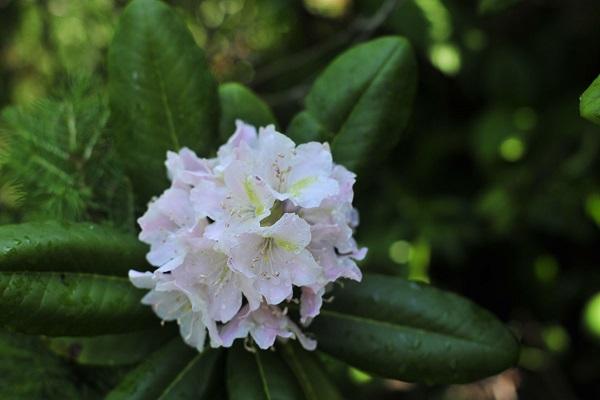
Slow growth
Rhododendrons are slow-growing shrubs. But sometimes it seems that the bush does not grow at all, the leaves wither, the flowers fall off. This negative phenomenon may indicate stagnation of moisture at the roots and waterlogging of the plant. When planting azaleas at the bottom of the planting pit, it is recommended to drain from expanded clay mixed with sand. It is unacceptable to grow rhododendrons in wetlands.
Reviews
Solovieva Lyudmila Arkhipovna, 48 years old, Saransk: “Several years ago she refused to grow vegetables on an industrial scale on her site. Having saved space, I decided to create a recreation area next to the house and the well. The husband installed several benches and a swing. Next to each bench and next to the well, Fantastica planted rhododendrons, next to them planted white roses and several hosts. It turned out to be a very interesting combination, when the azaleas fade, roses begin to shine, which look gorgeous against the background of dark green bushes. Now the whole family is resting there, during the flowering rhododendrons smell great, I recommend. "
